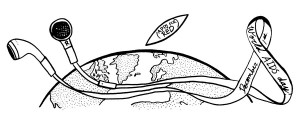Tech campaigns that promote ethical consumerism fall short
As the holidays jingle in, the newest color of the season seems to be Apple (RED). In an unprecedented two-week campaign that began Nov. 24, tech giant Apple Inc. will be donating a portion of its holiday sales from retail and online stores to (PRODUCT) RED, a licensed brand with a mission to rid the world of HIV/AIDS in Africa by engaging the private sector. Though raising funds for a cause seems exclusively beneficial, the ethics and efficacy of this so-called “conscience consumerism” concept should raise questions.
Founded in 2006 by activist Bobby Shriver and U2 lead singer Bono, private company (RED) has partnered with a slew of companies that include Nike, American Express, Armani, Beats Electronics and Starbucks. (RED) will donate a percentage of the funds it receives from partner brands to the Global Fund. In exchange, these partner brands benefit from the opportunity to increase revenue through the (RED) license.
Apple seems to be cashing in on the holiday shopping frenzy with (RED). On Black Friday, all U.S. Apple stores and online counterparts offered customers buying select products a special edition (RED) gift card. Yesterday, for World AIDS Day, Apple donated a portion of all in-store and online purchase to the cause. The campaign also includes 25 partnering app-makers, from the teams behind Angry Birds, Toca Boca and more, which will donate all proceeds from purchases of their apps or in-app upgrades to (RED).
Though it’s a case of ethical consumerism, it also seems to be a show of slacktivism, a term used to describe an act of showing support for a cause to make people feel morally superior with minimal personal effort. Campaigns like this beg the question of why a retail middleman between the charity and the donor is needed in the first place.
In fact, the campaign seems like more of an effort to associate private corporations with charitable causes for the sake of image rather than pure philanthropy. After all, each company will return a share of the profits from the sale of (RED) products — only in exchange for an opportunity to increase their own revenue and profits by attracting more social-conscious consumers. There’s also a lack of transparency when it comes to the proportion of profits from (RED) products donated to the Global Fund after (RED) receives funds from companies like Apple.
Not to mention, according to news site Philanthropy Action, participants such as Gap, Motorola and Apple have invested $100 million in (RED) advertising but have only raised about $18 million for the Global Fund. The disproportionate ratio between the marketing outlay and funds raised is alarming. In her piece “Costly Red Campaign Reaps Meager $18 Million,” AdvertisingAge writer Mya Frazier mused, “[Is] the rise of philanthropic fashionistas decked out in Red T-shirts and iPods really the best way to save a child dying of AIDS in Africa?” Other voices hit the nail on the head as well. Buylesscrap.org is a site that encourages people to give directly to the Global Fund, with the rallying cry, “Shopping is not a solution. Buy less. Give more.”
Only time will tell if this edgy, innovative campaign will inspire consumers to become better citizens or serve as just another excuse to feel good about themselves. In theory, it might sound appealing, but the campaign could easily shift into the realm of cause branding instead of corporate social responsibility.
Valerie Yu is a junior majoring in English. She is also the editorial director of the Daily Trojan. “Point/Counterpoint” runs Tuesdays.



Dear Valerie
Thank you for your interest in (RED)’s efforts to raise money and awareness for the AIDS fight and particularly this year’s World AIDS Day campaign. There are a couple of inaccuracies that I would like to address:
I think it’s important first to clarify the reason for (RED)’s existence. It was established in 2006 to drive a sustainable flow of corporate dollars to the Global Fund. As you may know, the Fund was established in 2002 as the world’s ‘war chest’ to fight three preventable and treatable diseases – AIDS, Tuberculosis and Malaria. From day one, its charter was to be a public-private partnership, with funding coming from both governments and the private sector.
In its first four years of operation, while it received great support from the public sector, the Fund had managed to get only $5 million from the corporate sector. If this dynamic didn’t change, there was a risk that government support for the Fund might diminish. Bono and Bobby Shriver created (RED) to solve this problem. In its eight years of existence, (RED) has generated over $275 million for the Global Fund’s fight against AIDS, every single penny of which has gone to work on the ground. There is no overhead removed by either (RED) or the Global Fund.
The article you cite about marketing dollar imbalance vs donations to the Fund actually originated in an erroneous piece from Ad Age in 2007. Both the figures cited and the implication that (RED) was spending millions of dollars in marketing is wrong.
Part of (RED)’s job is to convince our partners to use some of their existing marketing budgets to sell more (RED) products and keep awareness levels high about a pandemic which has killed 39 million people to date – unnecessarily dead from a preventable, treatable disease.
We’re proud that, according to the latest Global Fund reports, (RED) money has supported HIV/AIDS grants that have impacted the lives of 55 million people. We’re
grateful to our partners for choosing to play an active role in the AIDS fight, generating millions of dollars for the Global Fund annually.
We’re happy to talk about (RED) and the AIDS fight anytime if you’d like to get in touch.
Sincerely,
Sheila Roche
Head of Communications, (RED)